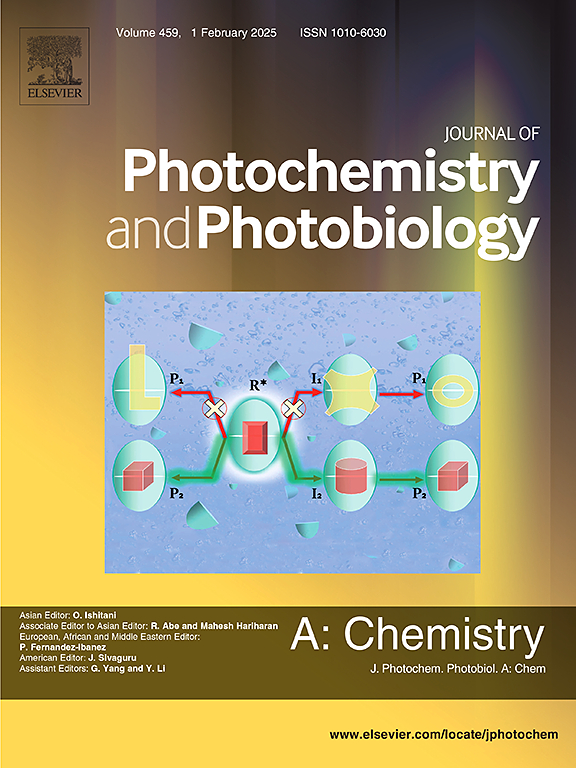Optimizing photodynamic therapy: Talaporfin-encapsulated silica nanoparticles for red blood cell disruption in cancer treatment
IF 4.1
3区 化学
Q2 CHEMISTRY, PHYSICAL
Journal of Photochemistry and Photobiology A-chemistry
Pub Date : 2025-02-24
DOI:10.1016/j.jphotochem.2025.116356
引用次数: 0
Abstract
Photodynamic therapy (PDT) is a highly effective cancer treatment that combines a photosensitizer (PS), and light for targeted cancer cell destruction in present of oxygen. However, the delivery of photosensitizers remains a challenge due to degradation risks and systemic toxicity. This study investigates the encapsulation of Talaporfin, a second-generation chlorin-based photosensitizer, within silica nanoparticles (SiNPs) to enhance PDT efficacy and safety. The research focuses on using red blood cells (RBCs) as a model system, highlighting their critical role in the tumor microenvironment. By targeting and destroying RBCs in proximity to tumors, PDT can disrupt the oxygen supply, indirectly leading to cancer cell death. Talaporfin-encapsulated SiNPs (T-SiNPs) were synthesized via a microemulsion method and characterized for size, morphology, and stability. The photodynamic effects of encapsulated versus naked Talaporfin were evaluated under varying concentrations and light exposure times. Results revealed that T-SiNPs achieved higher therapeutic efficacy, requiring lower concentrations and shorter exposure durations. This enhanced performance is attributed to improved light absorption and ROS production due to reduced aggregation of Talaporfin within SiNPs. Additionally, mathematical equations were developed to correlate the concentrations of encapsulated and naked Talaporfin with the 50% mortality rate (t50) of RBCs. These equations provide a predictive framework for optimizing PDT protocols, enabling the determination of optimal drug concentrations and exposure times without extensive experimental trials. This study underscores the potential of silica nanoparticles as efficient carriers for photosensitizers, enhancing PDT outcomes by targeting both RBCs and cancer cells. The findings pave the way for innovative cancer therapies that leverage nanotechnology to achieve precise, effective, and safer treatments. Future applications of this approach may extend to broader therapeutic areas, further revolutionizing modern medicine.

求助全文
约1分钟内获得全文
求助全文
来源期刊
CiteScore
7.90
自引率
7.00%
发文量
580
审稿时长
48 days
期刊介绍:
JPPA publishes the results of fundamental studies on all aspects of chemical phenomena induced by interactions between light and molecules/matter of all kinds.
All systems capable of being described at the molecular or integrated multimolecular level are appropriate for the journal. This includes all molecular chemical species as well as biomolecular, supramolecular, polymer and other macromolecular systems, as well as solid state photochemistry. In addition, the journal publishes studies of semiconductor and other photoactive organic and inorganic materials, photocatalysis (organic, inorganic, supramolecular and superconductor).
The scope includes condensed and gas phase photochemistry, as well as synchrotron radiation chemistry. A broad range of processes and techniques in photochemistry are covered such as light induced energy, electron and proton transfer; nonlinear photochemical behavior; mechanistic investigation of photochemical reactions and identification of the products of photochemical reactions; quantum yield determinations and measurements of rate constants for primary and secondary photochemical processes; steady-state and time-resolved emission, ultrafast spectroscopic methods, single molecule spectroscopy, time resolved X-ray diffraction, luminescence microscopy, and scattering spectroscopy applied to photochemistry. Papers in emerging and applied areas such as luminescent sensors, electroluminescence, solar energy conversion, atmospheric photochemistry, environmental remediation, and related photocatalytic chemistry are also welcome.

 求助内容:
求助内容: 应助结果提醒方式:
应助结果提醒方式:


